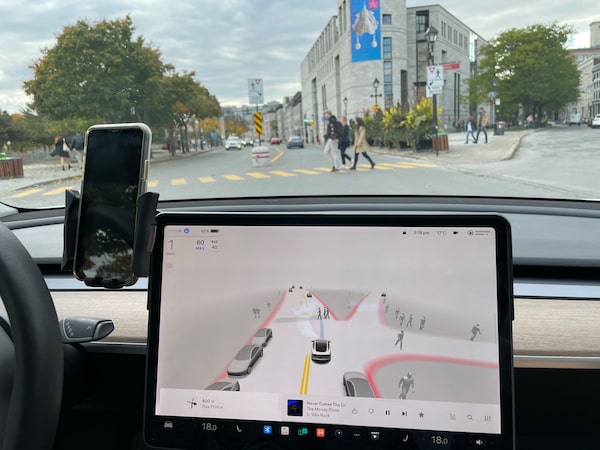
Petrina Gentile rides along with Elias Makos, host of The Elias Makos Show on iHeart Radio Canada’s CJAD 800, in Montreal in his 2021 Tesla Model 3 with the 'Full Self-Driving' feature.Petrina Gentile/The Globe and Mail
If you usually sit in traffic for many hours a week commuting to and from work, the idea of not having to drive can sound pretty enticing. So when Tesla Inc. touted its “Full Self-Driving” feature in 2020, it’s no wonder people wanted it. The problem is, Tesla’s FSD is not fully self-driving and the driver is ultimately in control.
Given all the marketing hype and multiple investigations into Telsa crashes, we wanted to see how the FSD system actually works.
All Tesla vehicles come with what the automaker calls Autopilot, a standard driver-assistance package designed for highway driving. All owners can now add FSD, which the company says works in urban areas, for an extra $20,000. Tesla says it uses this name to avoid changing the term every time a new software update is released.
While Tesla’s FSD system is one of the most advanced on the market, no car company, including Tesla, sells a fully autonomous vehicle. Its website and infotainment system says as much: “Full Self-Driving is an early limited-access Beta and must be used with additional caution. It may do the wrong thing at the worst time, so you must always keep your hands on the wheel and pay extra attention to the road. Do not become complacent.”
In Canada, there are no regulations prohibiting the use of FSD on public roads and, according to Elias Makos, one owner we drove with, adding the software doesn’t affect auto insurance premiums.
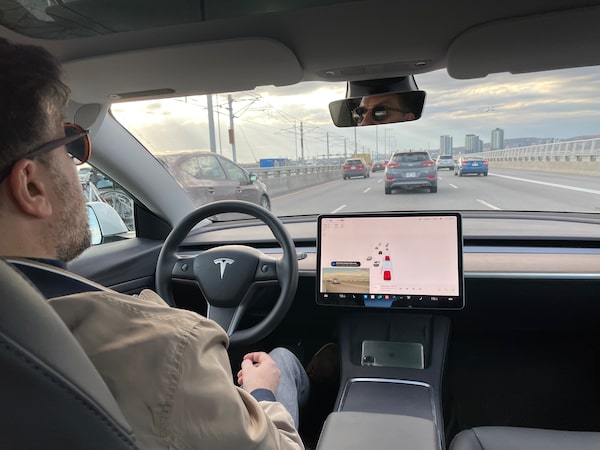
Petrina Gentile/The Globe and Mail
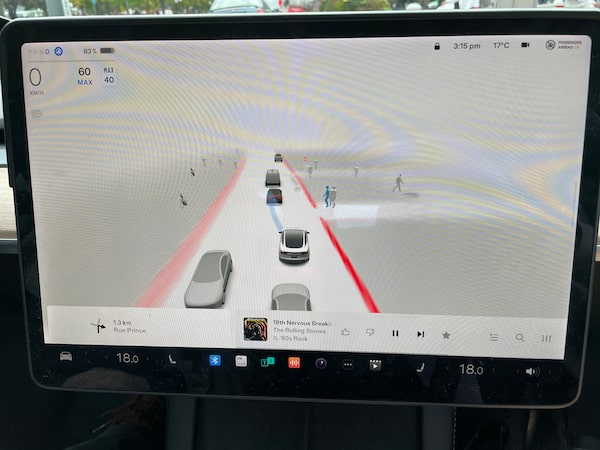
There are no regulations prohibiting the use of FSD on public roads in Canada, according to Elias Makos.Petrina Gentile/The Globe and Mail
We reached out to the Insurance Bureau of Canada to verify, but they declined to comment. Instead, they pointed us to a paper they released that discusses how collisions will be increasingly caused by product malfunction and product liability is more complex and takes longer to resolve claims. It recommends establishing a data-sharing arrangement with automakers, vehicle owners and insurers to help determine the cause of a collision.
The U.S. National Highway Traffic Safety Administration is investigating after a 2021 Tesla Model S changed lanes and then slowed abruptly, causing an eight-vehicle crash and several injuries in California in late November. The driver said the vehicle was in Full Self-Driving mode, but the police report doesn’t confirm this. The crash occurred hours after Tesla chief executive officer Elon Musk made the feature available to anyone in North America.
About a month before this crash, the chair of the U.S. National Transportation Safety Board, Jennifer Homendy, criticized Tesla for using a “misleading” name.
Currently, 160,000 Tesla owners in Canada and the United States are testing Tesla’s FSD Beta software, including Makos, host of The Elias Makos Show on iHeart Radio Canada’s CJAD 800 in Montreal. On a recent trip to Montreal, I got a first-hand look at Tesla’s FSD capabilities and limitations on Makos’s 2021 Model 3. We started in Montreal’s downtown core and headed to the South Shore suburbs on a route littered with right- and left-hand turns, construction cones, pedestrians, dogs, parked cars and cyclists.
To engage, Makos entered an address into the navigation system and tapped the right-hand gear lever down twice to start. Then, he took his hands off the wheel. When FSD is on, a camera in the cabin constantly monitors the driver’s attention, reminding them with audible and visual alerts to keep their eyes on the road and touch the steering wheel frequently, though Musk has said drivers will soon be able to disable the “nag.”
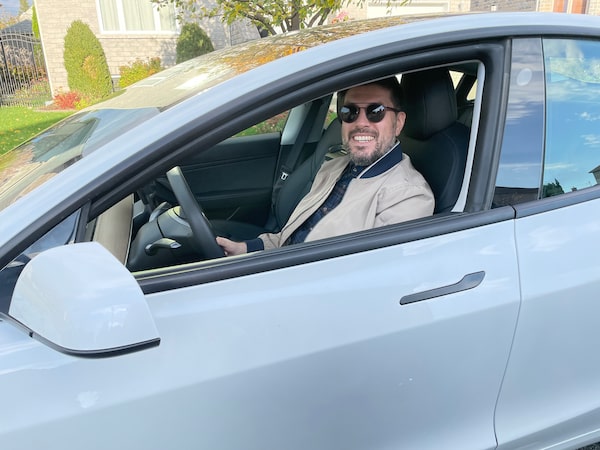
After nearly two hours of driving, Elias Makos reported three unsafe manoeuvres to Tesla.Petrina Gentile/The Globe and Mail
Eight external cameras capture every detail of what’s going on outside the car and display it on the large centre screen. There’s no expensive radar or ultrasonic sensors any more; even though Makos’s car came with radar, the system relies solely on the cameras. The cameras mapped out the surroundings in real time, including multiple driving lanes, bike lanes, pedestrians on the right and left side of the street, other vehicles on the road, parked cars and cyclists. Red lines indicate high certainty that it cannot drive beyond that point because it’s not a road. “It is [incredible] how many independent objects it’s keeping track of. At the end of the day, this is safer than I am,” Makos said.
The system was impressive: The vehicle kept up with traffic, changed lanes to avoid parked cars, turned right and left, obeyed traffic signals and stopped at stop signs. It drove around parked cars and recognized pedestrians who jaywalked.
“They didn’t have the right to cross there, but the AI determined their intent was to cross. So it slowed down and stopped to let them cross. It’s impressive. It is super safe with pedestrians. In the dark, it’s unbelievable – it’s even better. It can see better than a human in the dark,” Makos said.
Making a left turn, the traffic light changes from green to yellow, and instead of proceeding like most humans would do, the vehicle stopped and waited for the next green light. //It did so before the lane marking, too, so we weren’t stuck in the middle of the intersection.
Makos drove for about 15 minutes before touching the accelerator. He only did so when the vehicle hesitated to proceed and other drivers got annoyed, honking their horns. “The No. 1 thing I’ve been doing is pressing the gas to give it more confidence. It’s too hesitant at times. It’s too cautious,” Makos said.
He added that the main reason he takes over is because he’s in a rush.
FSD does have limitations. “It can struggle if you have multiple lanes in a city like Montreal,” he said. “Sometimes there’s no lane markings or – surprise – you’re all of a sudden in a turning lane. This is where there is definitely room for improvement.”
On the highway, the system automatically switches from Full Self-Driving to AutoPilot. It can change lanes on its own, stay centred in the lane, maintain a safe distance from the vehicle ahead and exit. The driver doesn’t have to do a thing other than stay alert and be ready to take over in the event something goes sideways. When the highway ends, it automatically switches back to FSD mode. The transition is seamless.
When I drove his Tesla in FSD mode on the South Shore of Montreal, I was on edge. It was nerve-racking when, for example, it attempted a U-turn at a traffic light and then changed its mind and went straight. I took over quickly, which disengaged the system. Makos reported the glitch to Tesla by touching the centre screen. “How many times has a human done that? Human drivers pull that same kind of nonsense all of the time,” said Makos.
In most cases, though, it drove well, avoided construction cones, and made right- and left-hand turns confidently. It even changed lanes to avoid a dump truck. While it identified the truck, it didn’t recognize police cars or move over when an ambulance approached with flashing lights. Makos also reported that to Tesla.
Back in downtown Montreal, it navigated roads with faded line markings, lanes that ended abruptly and switched lanes when traffic was moving faster one lane over. After nearly two hours of driving, Makos reported three unsafe manoeuvres to Tesla. Over all, it worked well 90 per cent of the time and, as long as you’re paying attention, there’s no need to worry. Confidence in the system builds quickly when you’re behind the wheel, but drivers need to remember that this is not a self-driving vehicle.
If you want an indication that people have confidence in the FSD system, or at the very least, in its future promise, Makos said that Telsa has doubled its price in Canada. He paid $10,000 for it in 2021.
Shopping for a new car? Check out the new Globe Drive Build and Price Tool to see the latest discounts, rebates and rates on new cars, trucks and SUVs. Click here to get your price.
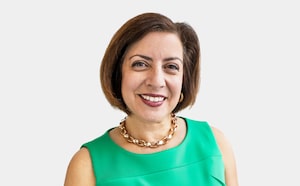 Petrina Gentile
Petrina Gentile